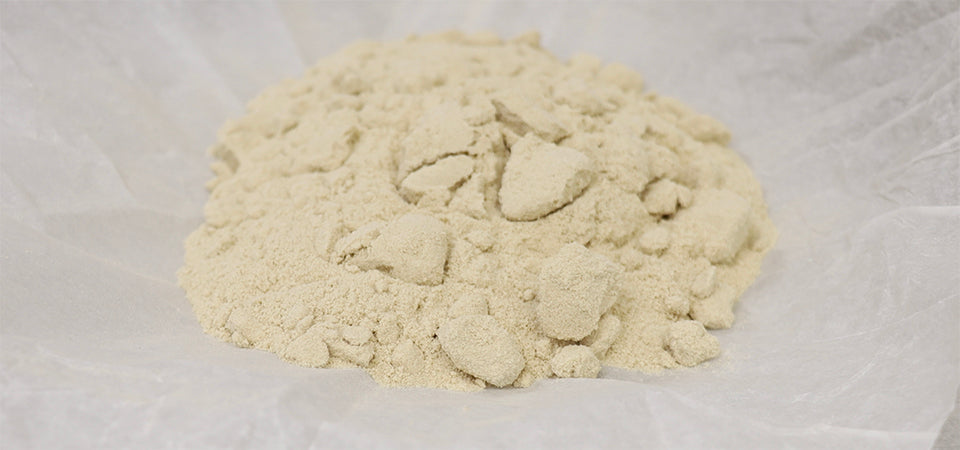Types of Hash - Differences in Hashish Explained

There are many different types of hash—both ancient and modern—that cannabis connoisseurs enjoy for their concentrated effects and unique flavors. Ancient varieties of hashish ("grass" in Arabic) are generally named for their place of origin while modern varieties are named for their production technique.
Growers and extractors can capitalize on the diversity of hash products by preparing a wide range of cannabis concentrates for consumers. Because modern hash is generally much higher in quality (and potency) than the import hash varieties that are available these days, we'll focus upfront on modern types of hash.
Modern Solventless Hash Products
Solventless hash products are made by isolating the sticky resin-containing trichomes that develop on mature cannabis plants. These resin glands are where the cannabis plant's cannabinoids and terpenes develop, and separating them from the buds results in an extract with a higher percentage of cannabinoids compared to smoking whole cannabis flower.
Modern hash products are characterized by a technologically supported production process that allows for greater purity and consistency and a much higher retention of terpenes compared to traditional hash-making methods. At Lowtemp Industries, we stock the solventless extraction equipment you need to make several of the following hash products.
Dry Sift Hash
Dry sift hash is the closest thing to traditional hash types that we see on the U.S. market today. Dry sift hash is produced by lightly rubbing dried cannabis buds over a sieve and then refining the kief that comes off through a graduated series of metal screens until mostly trichomes remain.
Dry sift hash can be pressed on a rosin press to extract the resin (for dabbing) or decarbed and used to make edibles and topicals. Static Tech is often used to clean up dry sift before it is pressed.
Bubble Hash
Bubble hash is a kind of hash that is produced using ice water extraction. Bubble hash is also known as ice water hash. The extraction process is as follows:

- Frozen cannabis buds are placed in a bucket or chamber filled with ice and cold water.
- Gentle agitation causes the trichomes to separate from the plant material and fall to the bottom of the chamber.
- The contents are emptied into a separate bucket lined with a graduated series of bubble bags or an AutoSieve, which capture different-sized trichomes.
- The wet hash is dried in a freeze dryer or cold room.
Full Melt Bubble Hash

Full melt bubble hash refers to bubble hash that melts completely and without leaving residue when dabbed. This quality of bubble hash is typically made up of trichome heads in the 90-120μm range.
Full Spectrum Bubble Hash
Full spectrum bubble hash is made using the full micron range of the bubble hash collected, minus the smallest and largest size wash bags, which tend to collect the most unwanted plant material. Full spectrum bubble hash is said to have a more complex flavor profile than bubble hash from a single micron size.
Temple Ball
Modern temple balls combine the idea of Nepalese temple balls (which we describe lower down) with the more recent technique of ice water extraction.

- Dried bubble hash is placed inside a turkey bag and rolled out with a wine bottle filled with hot water.
- After it's been rolled out several times both ways, the hash is folded over to make a cube.
- The cube is worked with the hands to get rid of any air pockets and inconsistencies.
- The cube is shaped by hand into a ball.
- The ball is stored in a cold environment and aged.
Temple balls offer two primary benefits: (1) The exterior protects the resin inside, and (2) The use of heat in the preparation process starts to activate the cannabinoids for greater therapeutic efficiency.
Piatella
Piatella is a fairly new hash product that was created by Zio from Uncle’s Farm with bubble hash from La Sagrada Farms and Slite 23. This hash product won 3rd place at Ego Clash 2020. Essentially, piatella is cold cured full melt bubble hash made from fresh frozen cannabis buds. It is so rich in terpenes that it binds together and slices like a soft loaf of bread. As you can only make piatella with full melt bubble hash, this product typically consists of trichomes in the 90-120μm range.
Rosin

Rosin is the filtered resin of the cannabis plant. It is extracted by pressing bubble hash, dry sift, kief, or dried cannabis flower between two heated plates until the trichome cuticles melt and the sticky resin flows out. This resin can then be dabbed or decarboxylated and infused into edibles and topicals.
The best rosin is obtained by pressing premium bubble hash, although you can produce a good economy rosin by pressing static-cleaned premium dry sift. After pressing, rosin can be cold-cured to create a budder texture or warm-cured to create jam, sauce, and diamonds. You can also achieve a shatter-like texture by pressing bubble hash at higher temps.
Modern Solvent-Based Hash: BHO
Butane hash oil (BHO) extracts are similar to solventless hash extracts in that they contain the active compounds of cannabis without any excess plant material. The main difference between solventless and solvent-based hash products is that solvent-based hash products are made by dissolving the cannabinoids and terpenes into a solvent (and later purging off the residual solvent) whereas solventless hash products are made via mechanical separation.
After extraction, BHO can be further processed and manipulated to create a wide range of textures, including:
- Honey oil
- Budder
- Badder
- Wax
- Shatter
- Crumble
- Pull-and-snap
All of these concentrates are typically dabbed. They can also be used to make infused joints, edibles, topicals, and vaping products.
Traditional Types of Hash
Traditional hashish (hash) types are defined by country of origin, centered around Central Asia and the Middle East. The best way to try these hash products is to travel to the countries in question (or Amsterdam) as illegal "import hash" in a Madrid study was found to be contaminated with hair, vegetable remains, plastic, sand, textile fiber, and worst of all—E. coli from human feces.
Please note that cannabis is illegal in some countries where hash is made, and its cultivation is limited to tribal regions or places where it can be grown and processed for research purposes. It’s also important to keep in mind that many traditional hash-making methods (especially those that involve direct contact with the hands or feet) aren’t considered sanitary by modern standards.
Charas (India, Pakistan, Nepal, and the Himalayas)
Charas or finger hash is made by rubbing live cannabis buds (typically Cannabis indica) between your hands so that the trichomes stick to your fingers or gloves. The trichomes that are collected are then rolled into a stick or sausage and traditionally smoked with a chillum.
The residue that builds up from rolling fresh buds in one's hands is dark green, almost black because it contains plant residue and typically also dirt, stigmas, and anything else that might have fallen on the plant. The advantage is that this soft creamy hash is very aromatic when it's fresh because the terpenes haven't had time to degrade.
Afghani Hash
Afghani hash is made by separating the trichomes from dried cannabis buds to get kief and then baking and pressing the kief over a low-heat wood fire—sometimes with warm water, tea, or animal fat. Once the dark-colored mixture resembles dough, it is then kneaded by hand or with people’s bare feet until it's around the thickness of fudge. Quality Afghani hash comes with the producer's seal of approval and is said to taste spicy and harsh.
Kashmiri Hash
Kashmiri hash comes from Kashmir in the north of the Indian subcontinent. This kind of hash is said to be made in a similar way to charas and to produce a strong physical stone.
Lebanese Hash
The most famous Lebanese hash is made from marijuana that's grown outdoors in the Bekaa Valley. Once it's ripe, the buds are harvested and dried, the dried buds are sieved to make kief, and the kief is pressed into brittle hash slabs that are either yellow or red. Yellow Lebanese hash is described as being more stimulating whereas red Lebanese hash is described as being relaxing.
Manali Hash
Manali hash is made in the town of Manali, located in the Beas River valley in the Himalayan mountains of India. This mild hash is made by rubbing live cannabis buds (as with charas) and is so smooth that it's often branded as "Manali Cream."
Moroccan Hash
Cannabis was introduced to Morocco in the seventh century C.E. and the northern region of Rif became well-known for hash production in the 18th century. To make Moroccan hash, the locals beat dried cannabis buds over a sieve and then heat and press the kief into various sizes and shapes. Two notable varieties of Moroccan hash are Moroccan brick hash, which is brittle, and Moroccan pollen hash, which is soft.
Nepalese Hash
The idea for temple balls originally came from Nepalese temple hash. To make Nepalese temple balls, Buddhist monks are said to have rubbed the dried cannabis buds between their hands and then roll the trichomes that collected on their hands into shiny balls that were left to age for as long as a year or more.
Pakistani Hash
Black-colored Pakistani hash is made in the northern tribal areas of Pakistan. It is said to be produced in a similar way to Moroccan hash: sieved and then heated and pressed. The distinctive feature of some Pakistani hash is that it's aged for three months inside a dried sheep's or goat's skin to bring out the flavors.
Turkish Hash
Turkey hash is made in certain provinces where cannabis cultivation is allowed for medical and research purposes. Like with Moroccan and Pakistani hash, kief is heated and pressed into black hash slabs, which end up being quite brittle. The smoke is said to be smooth with a little spice. The high is mild and strongly cerebral.
Join a Proud Line of Hash Makers
Hash making has been around for a long time and continues to evolve as new techniques are discovered, new technologies are invented, and the tastes of the cannabis market shift and change. All forms of hash are concentrated by nature. However, there is a vast difference between old-world hash types from traditional hash-making communities and modern types of hash like rosin, bubble hash, and piatella.
If you're interested in processing cannabis to make hash for commercial or personal use, it's important to start with top-tier extraction equipment and high-quality starting material. Cutting-edge, durable equipment that can be programmed for consistent results can help you produce hash that modern consumers will love.




